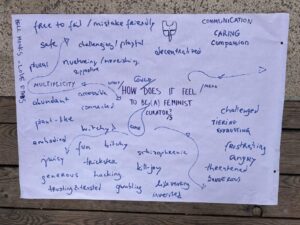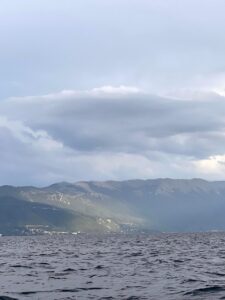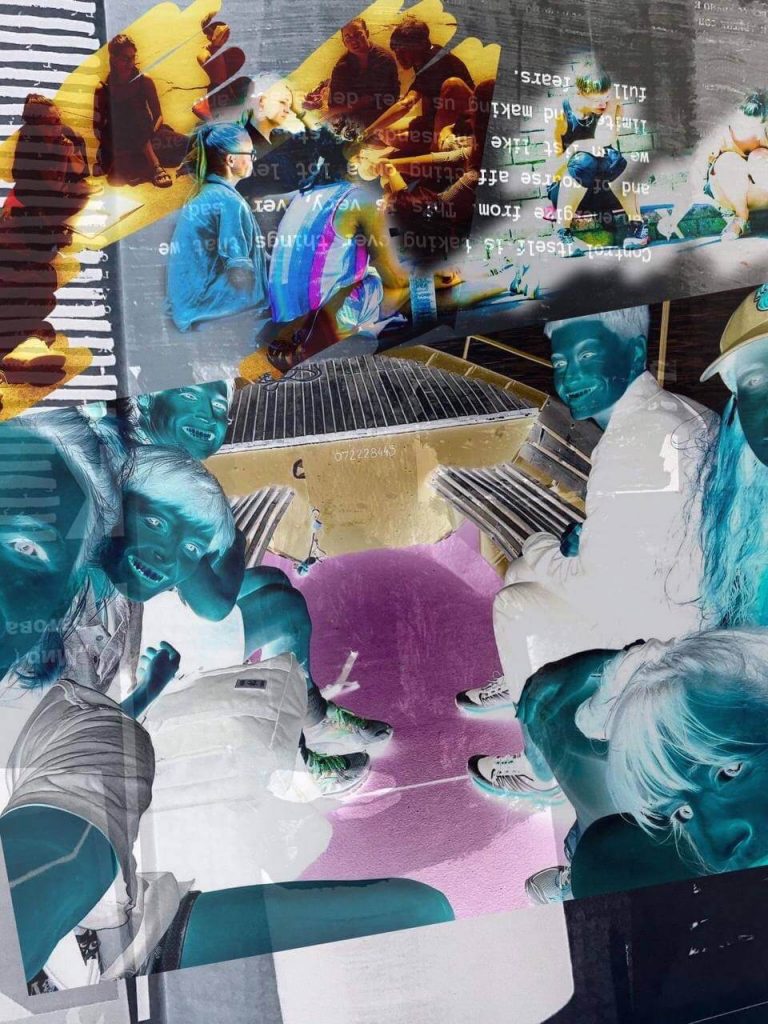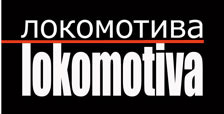Curating in Context Summer School
Struga, North Macedonia
August 29 – September 5, 2022
“Con-texts: the curatorial, the lake, the writing bodies and bodies of water”
Few notes from Struga Summer School / a collective diary of sharing thoughts
Anka Herbut, Elena Novakovits, Jette Buchsenschutz, Kasia Wolinska, Maeve Johnson, Masa Radi Buh
Where is your body now? How does it feel?
Cause my body, for instance, is trying to recall and tune in to the feeling it experienced when the above questions were introduced at the very beginning of the Summer School in Struga. We were sitting on a sunny terrace in a circle, facing each other, trying to return to our bodies in order to feel what we’re coming with, what we could bring into the collective process that was just about to begin, what we were ready (or not) to share. My body came to Struga quite overwhelmed by holidays which actually were not so holidayish, but instead they were rich in deadlines, taking care for others and no-time-to-loose-tasks. So my body was somewhere in between tightening muscles there on the nape of my neck, and a relief dissolving my tension thanks to the fresh waters of the primeval Ohrid Lake – a slowing-down teaser promising to experience something here.
The Summer School was held in Struga in the south-western part of Northern Macedonia, where I have never been before. The context was new for me – as it was for all of us. After having spent the prequel few days in Skopje – a city touched with the statuecompulsion, I found this decentralizing decision to meet in Struga bold and tempting, and soon I also realized that it brought my thinking about curatorial practices down to earth, maybe even to the underlands of its mission, to the very context of where we are, what we can(not) give to the context, what we can(not) take from it, what temporalities we still keep in our bodies, and with who we would be shifting them in days to come.
But let’s come back to the roots for a moment, i.e. to the curatorial. The Summer School Curating in Context was structured around lectures and discussions maintained in a spirit of collaborative learning – given by the internationally established theoreticians from the region who deconstruct curatorial practices as well as by locally established cultural animators struggling with the failure of the authorities to understand necessities of the local cultural field. In her lecture on curation and care Bojana Kunst stressed that the very term curator stems from the Latin word curare, which basically means to take care about / for. Yet as Biljana Tanurovska-Kjulavkovski mentioned in her speech, now even the store windows are curated, so in the meantime the mythical care also sailed through the more commercial, commodified waters… However, in the 1990s the curatorial turn has shifted the focus of curatorial practice and extended its notion, so it could no longer be about displaying the artworks (preferably objects) in a whitebox. It must have rather shapeshifted and gone to the areas of process-knowledge, focusing on the research-based pursuits, feminisming institutional work, gaining political and contextual (preferably glockal) consciousness and creating an interdisciplinary drive for building affective relations between artists, institutions, and the audience. And insofar it was previously possible to think or dream about governing a position of a curator, now we would need to dream on mediating, navigating, facilitating, contextualizing, taking care and being cared about / for. I somehow feel curatorial practices as a radar to the social changes and challenges – a radar that can undermine the status quo and give a glimpse of the relations, constellations, feminist approaches and collectivities that are just coming.
So how do you think, how does it feel to be a feminist curator?

Collective mapping of a feminist curator’s feelings in a frame of Mapping the Curatorial Feminisms workshop
It was one of the questions proposed by us during the workshop Mapping the Curatorial Feminisms we facilitated in the frame of the Curating in Context Program. Interestingly enough the discussions started with sharing feelings of exhaustion, extraction, and depletion. Practicing feminist curating as a frustrating as opposed to an empowering narrative? Does it reflect the art system’s widespread exploitation of care delivered by underpaid and overworked, mostly female independent curators and if lucky employed curatorial staff? And might this frustration be also related to the recent exploitation of caring activism by turning it into cultural capital for commodification and spectacularization? To the appropriation of feminist activism as an additional value for critical and caring curating?
Then how could and should a feminist curator feel like (without neglecting the very relevant thoughts above)? This permeable body of a feminist curator would: make time and space for collaboration and exchange, for sharing practices and ideas across differences and conflicts, for identifying, responding to, and caring for specific and individual needs. It would feel the urgency to attend to questions of precarization, vulnerabilization, exploitation, and the exhaustion of our bodies. It would feel the importance of interrupting the flow of the system – to talk about our privileges, our mistakes and the fear of change. It would pay attention to herstories. It would stay with the trouble. It would feel like a witch hacking the system 🧙♀️.
What is the problem with/of the context?
Different contexts which were in encounter in Struga where people came from numerous corners of European and non-European, faced us with an awareness of specifics which arise from them. To be conscious of contexts is to continuously be attentive of our privileges, to take note of systemic cultural conditions, amongst which there are funding opportunities and budgets but also current and past political realities, and to situate our perceptions, our values, our needs and our problems into the present which shapes them. If the context is somehow forgotten or ignored, however, the site of meeting of our differences and conflicts is in danger of becoming merely a personal opinion, or in the context of curation a playground/a chessboard for cooperative and/or trendy interests and ideas which then can easily seem completely out of context.
How did the powerful lake Ohrid shape the context of our stay in Struga?

Βeyond theory / curation as a mode of interacting / or a kind of cultural advisor diary: Although I have in front of me a ‘privileged’ notebook full of – formal and informal– information about what is curation, the figure of curator, contexts, policies, strategies, tasks, unknown initiatives (up to then) and so on (and indeed all these I hope to find a reformulated shape and space for activation within my professional trajectory!) – mainly, I was wondering what remains from these encounters? I remember when I was there, I was thinking a lot that curation is all about how one can structure a framework of safety, openness with focus on micro-politics and fair practices – away from hierarchical structures and power relations – where anyone can find their space to just express themselves. YES, you can have the skill to choose ‘successful’ performances and ‘brilliant’ artists, or/and to invite the intellectual minds to contribute. But, how about creating the conditions to feel someone that can act and exist somewhere with their singular identity without provoking feelings of uncomfortness?
I recall Curating in Context as a gathering (instead the term school gives me anxiety) where the theory, the presentations and the production of knowledge through multiple formats went hand in hand with the effort to develop and sustain relationships of intimacy, everydayness and care (without the misuse of the term!). Ι don’t know if it was the Ohrid lake and its spirit, the unpredictable weather or the size of the city that hosted us, the warmth of the local community, but YES, I guess you should always need to contextualize how, where, why and with whom you organize something. And to get even more personal (perhaps as a diary of my teenage personality), I recall Struga with tastes of local salads, wine(s), wrongly ordered quantity of traditional plate with cheese, cappuccinos with whipped cream, new faces, taxis, a floating boat in the middle of nowhere, cigarettes everywhere, even more cheese, the sounds of forgotten Abba tunes (although there was a hidden curatorial logic as this meeting was also a collaboration with the Stockholm University), a pool, stomach disorders, the (happy) absence of Covid and masks, a huge breakfast, a huge private room (!) and unpredictable dancing moments. Αnd certainly, I cannot forget that windy afternoon when we were trying to organize the workshop and the next steps of our group, but personal and sincere conversations about life, death, and magic pills overcame any ‘professional plan’ and, then another question came to my mind: which are the contexts of collaboration and mutual understanding in which we would like to curate our work, production, research, existence?
Maybe I start with desire; in the context of patriarchal, colonial and capitalist (aren’t these words all synonyms of each other?) dystopia, as cultural workers we are obliged again and again to work, to labor. Isn’t then a summer school another opportunity to fulfill this obligation: to learn, to network, to teach, to produce, to talk, to be at-work? What choice do we really have other than to attend these events? But I would propose a counter-narrative: I wanted to be there.
I don’t ever wear jewelry but at Struga I felt a call to get a ring with pearls. I wear it almost everyday. For some reason, the place became important and I carry it with me. The pearl is made out of fishbones from the lake.
And so, which are the contexts of collaboration and mutual understanding in which we would like to curate our work, production, research, existence?
Desire is located in the body-self and yet it reaches out to the other, be it person, object or lake. I wanted to swim, I wanted to feel my body in the water and I wanted the water to engulf my body. I wanted curiosity and having one drink too many, I wanted excess and pleasure, I wanted empathy, sensitivity, humor. I wanted to listen, I wanted to talk, I wanted to dance with my friends (yes friendship is possible in dystopia!) and I wanted to share in the collective labor of (re)thinking curatorial practices. For me desire is a context in which I want to curate our work, production, research, existence.
Maybe it is important to talk about safety first. Part of queerfeminst thinking has centered around safe(r) spaces: shelters where we can huddle against the oppressive structures of capitalism, patriarchy and colonialism – bunkers from which we can subvert and sabotage the systems that oppress us. Yet safety can easily become exclusive: maybe where I am safe, you are not. So one possibility is an intersectional approach, we work with the maxim that none of us are safe until all of us are, and we look from the perspective of our most vulnerable to envision the safest spaces possible. But safety is not only enough.
One night in Struga I was working on an application for another project. I finished and submitted the application after midnight and decided that I wanted a walk, a beer and a cigarette before going to sleep. Being in a city foreign to me I decided not to dress in my usual manner (playful, expressive… well that’s what I assume at least) and wear simply jeans and a hoodie. I wanted to be safe. This time the strategy worked: my performance of a bland gender protected me from any potential violence (I would emphasize that jeans and a hoodie are often not enough to protect the wearer from violence and that this is absolutely a shame, a disgrace, a horror). I would ask: Is this what I wanted? Did I want to use strategies of self-censorship in order to protect myself from potential violence? Should it be my responsibility to protect myself if I simply want to walk on the street? In the face of patriarchal violence yes, I can create a safe micro-space for myself (or I can try to) but is this context enough for me to thrive? More broadly, is a safe context enough for us to work from or do we want more? We don’t want a piece of the cake, we want the whole fucking bakery.

Collage by Kasia Wolińska
So I return to desire. Safe as I felt for the most part during the gathering in Struga, I think it is so important to state that I felt good in my body-self. For the whole summer beforehand I had been struggling with feeling closed-off, isolated in my exhaustions, frustrations, obligations. Struga facilitated something else: a feeling of freedom, pleasure, fun. I was excited to meet and meet and meet again my collaborators, colleagues, co-conspirators. I wanted to share in this collective conversation in myriad ways: from breakfast chats to endless ridiculous jokes about our new best friend to deep discussions of theory and politics. I think this context of desire allowed me to leave behind my individualisation and reach out towards the other in order to create a context of collaboration and mutual understanding. So, while returning to curation as care, my question is this: how do we curate a context of collective desire?
So how do we curate a context of collective desire?
*****
Cover photo a collage by Kasia Wolińska.

